In the debut final stage of the UEFA Nations League, Portugal faced the Netherlands looking to become the first winner of the competition having overcome Switzerland and England respectively to reach the final.
Fernando Santos and Ronald Koeman came face to face but it was Gonçalo Guedes’ goal which decided the tie on the hour mark, racing through to fire in from the edge of the box after being teed up by Bernardo Silva. In a game of few chances, the Portugal side repeated their impressive feat of 2016 and once again lifted silverware at a European level.
This tactical analysis considers how Portugal saw off the threat of a young and rising Netherlands team which included the likes of Frenkie de Jong, Mathijs de Lijt and Champions League winners Georgino Wijnaldum and Virgil van Dijk.
Line-Ups
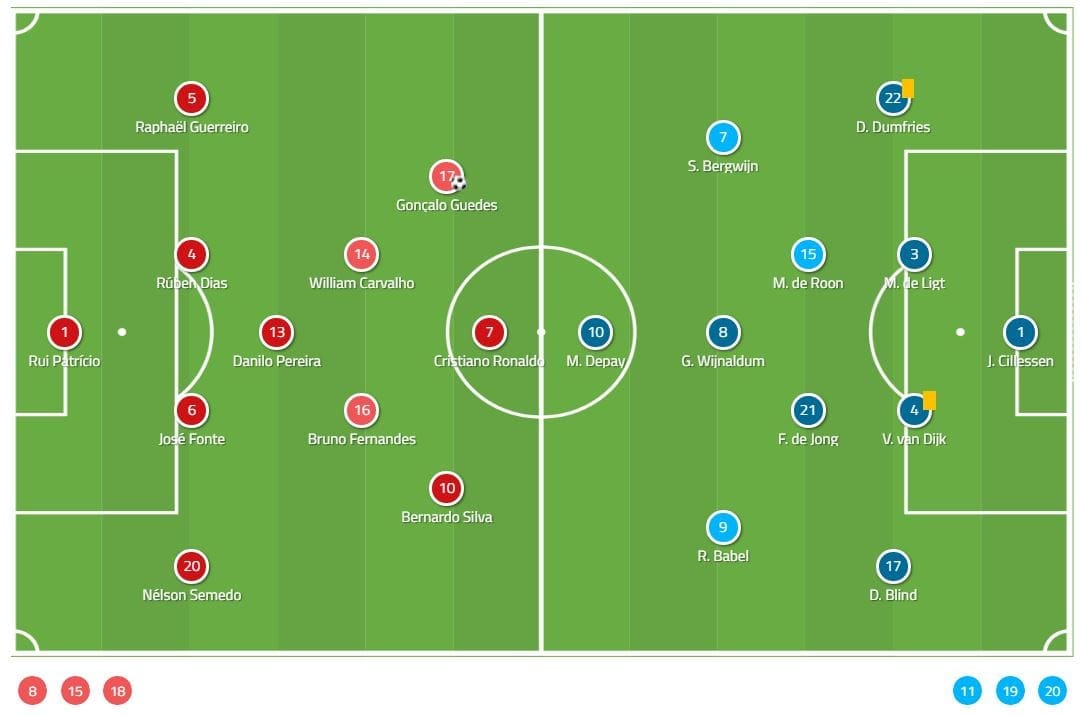
Portugal made two changes to the team which saw off Switzerland with Rúben Neves and João Félix replaced by Danilo Pereira and Guedes, the latter in particularly coming as a surprise to many given Félix’s meteoric rise and Guedes’ struggles for form. However, Guedes remains a favourite of Santos and provided the width which would prove to be crucial.
The Netherlansds on the other hand remained with the same starting XI as faced England. Some had hoped that Donny van de Beek or Quincy Promes could come into the side on either of the flanks after they impressed against the Three Lions, but Koeman stuck with his guns and it was former Liverpool and Fulham man Ryan Babel and PSV Eindhoven’s Steven Bergwijn who got the nod.
Portugal’s one-sided game plan
Right from the off it was clear that Portugal would look to rely on the wings in order to find a way through a Netherlands side which is very strong in the middle. From the opening whistle, attacks tended to verge towards the right flank but rapidly found that the more defensive minded Daley Blind proved to be tough opposition to surpass, even when they exploited Ryan Babel’s lack of discipline in-front of him with smart one-two manoeuvres son the counter-attack.
That saw Portugal change tac, with Bernardo Silva taking up more of a free role and drifting around the front line. That also granted more freedom to Guedes, who capitalised with more support and options when on the ball. With William Carvalho preferring to sit deeper, Silva could provide the link between midfield and attack on the left and Portugal’s set-up became more one-sided, with more than half of their positional attacks and 78% of xG from such attacks coming from the left wing.
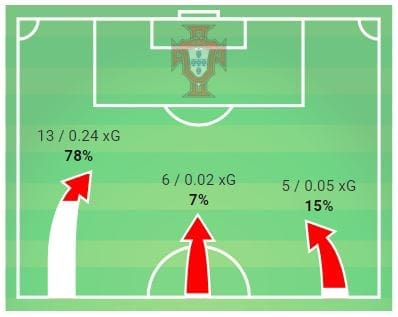
Denzel Dumfries was clearly targeted by Portugal at times, with the 23-year-old struggling, particularly as Cristiano Ronaldo and Bernardo Silva moved freely to apply the pressure in addition to Guedes. As the three moved around, it became increasingly difficult to follow and stick to one clear man. Whilst De Ligt and Van Dijk were up to the task, with Blind at times drifting in to act as a third central defender, Dumfries was left more isolated in a wider position. Portugal’s plan to attack that weak link was clear.
A lack of midfield cover
To counter-act that approach from the Portuguese, the Dutch looked to win through the middle. That is where their team possessed the clear quality advantage, far surpassing that available to their rivals and it was a logical approach to take as Portugal continually shifted the ball wide. However, it was a risky one which backfired when they lost possession. It was through just such a situation that Portugal found their winning goal, coming as the Netherlands midfield were slow to track back, with Frenkie de Jong allowing Bernardo Silva space to run through behind De Ligt after he was pulled out of position as Portugal moved the ball quickly down the flank with rapid runners.
Guedes immediately ran behind him after laying the ball through beyond De Ligt and to the Manchester City man, forcing Van Dijk to move across. With Blind reluctant to cover given Cristiano’s presence at the far post, it opened up a gap in the middle which Guedes exploited and Bernardo Silva was alert to identify it and set up the Valencia man to provide the finishing touch.
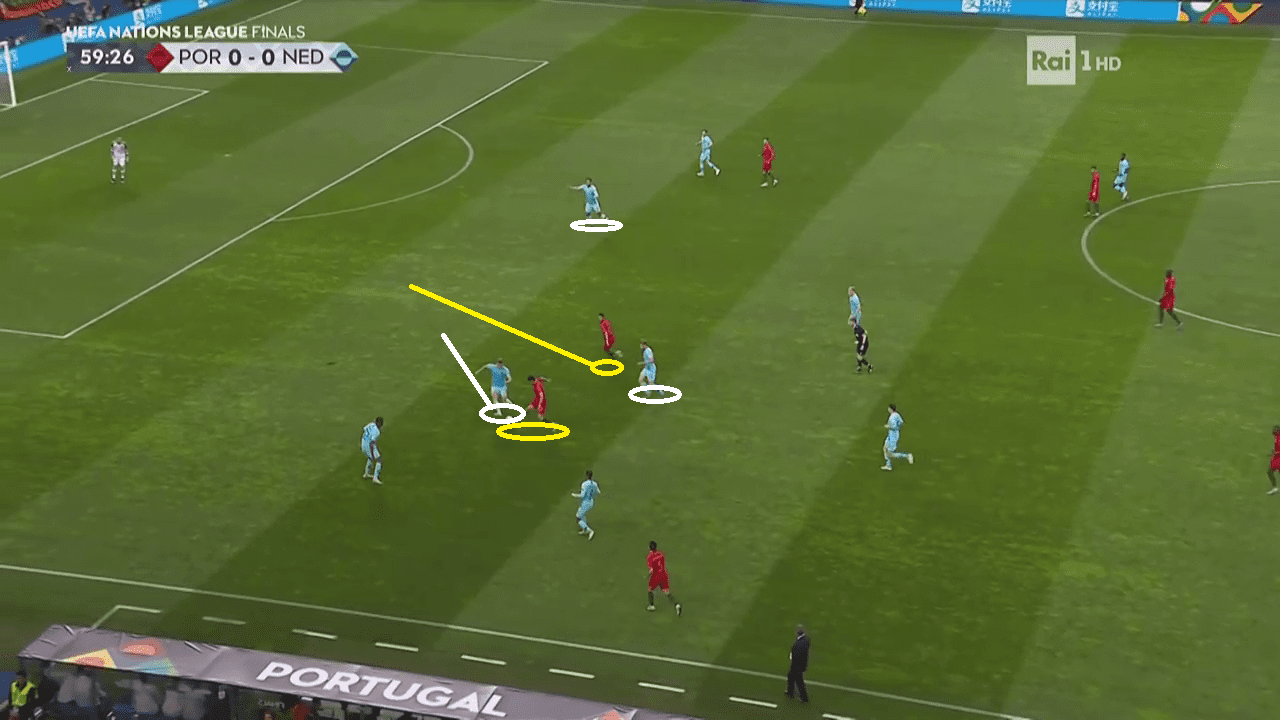
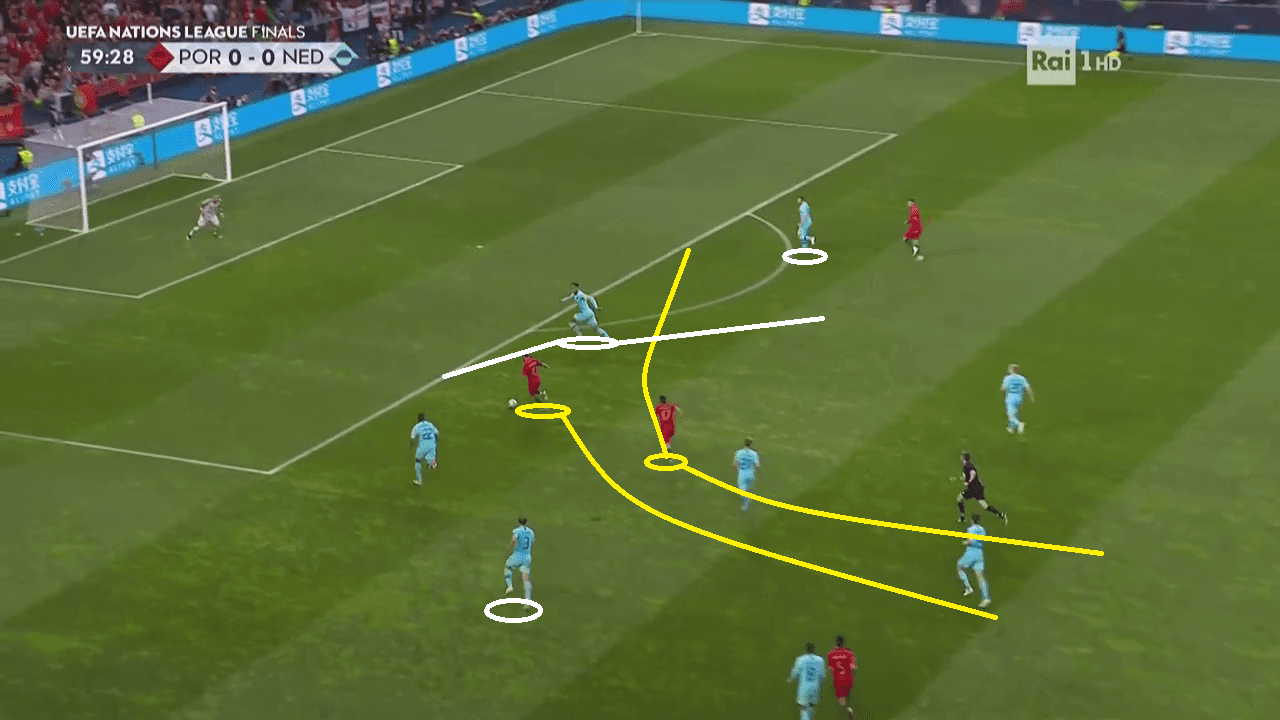
The approach showed the risk of the Netherlands piling forwards in midfield. Martin de Roon would typically have sat in a deeper role, ready to block any runs such as that by Bernardo Silva. Had he done so, De Ligt wouldn’t have been forced out and the defence would have retained its shape. Instead, De Jong and De Roon failed to provide the cover that the defence needed and Wijnaldum found himself in an even more advanced position.
Cutting the width to cut the options
The Netherlands’ decision to focus centrally also came unstuck due to the way in which Portugal defended. Their back four remained incredibly narrow, cancelling out the space and overcrowding the middle of the park. The result became that as the Netherlands entered into the final third, they suddenly lacked the space for their free flowing passing style and were instead looked to force the ball wide, where the wingers remain this side’s weakness.
It worked perfectly for Portugal, conceding only five shots, only one of which was on target. Memphis Depay was denied the space he needed to really thrive and use his pace against a defence featuring 35-year-old José Fonte. It also prevented the wingers from cutting inside and when they remained stuck out wide, the wingers would drop deep in order to protect the back line and form what was almost like a back six.
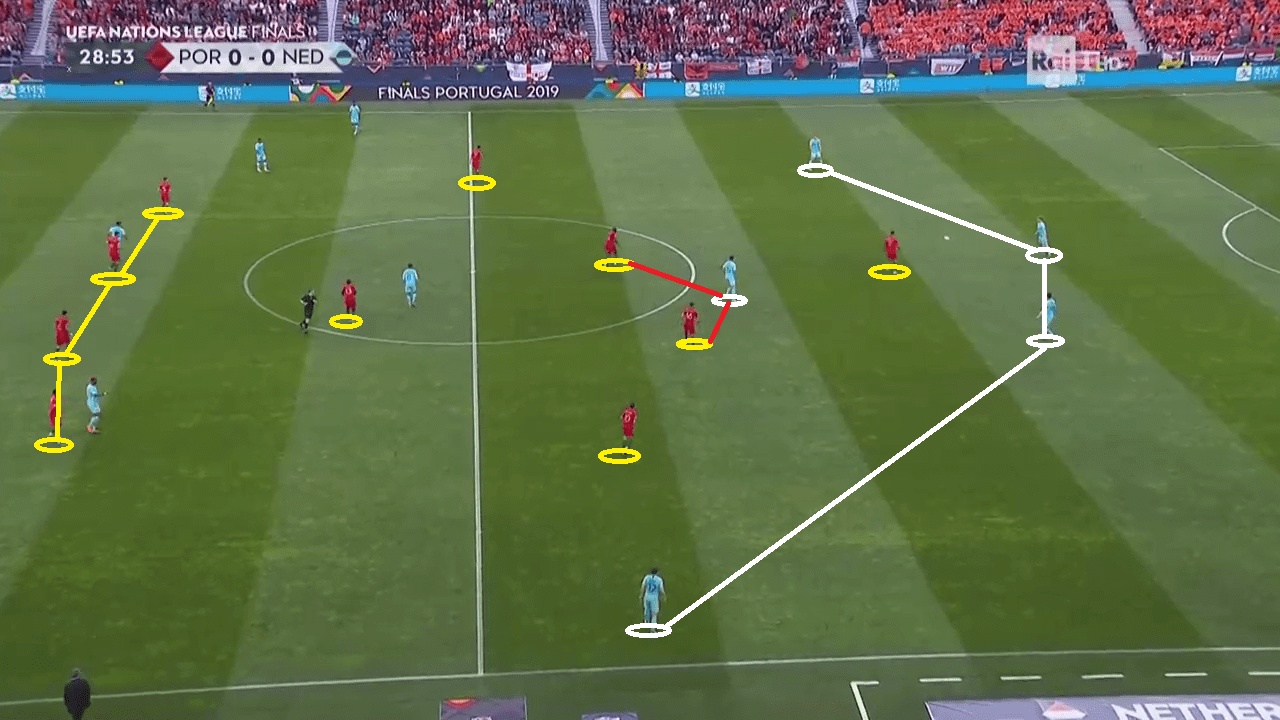
Another key part of Portugal’s defensive structure was to use their front three as a defensive tool. Cristiano applied a somewhat relaxed press but the other two forwards, Guedes and Silva, would look to block off the distribution point in midfield, usually De Roon but also alternating with De Jong and Wijnaldum. They would block his passing routes and look to quickly close down should he get on the ball, forcing him to play centrally to where the midfield were waiting or instead playing a hopeful long ball. The trap worked perfectly to disrupt the Netherland’s plans.
Sitting deep with the lead secure
This was emphasised by Portugal’s reaction to the goal. As soon as Guedes had found the back of the net, the team reverted into a much more deep-lying shape. That invited Koeman’s side to play their own game and retain possession, but they would be engaged the second the ball entered the final third.
Koeman was as such forced to adapt his strategy, encouraging his team to play the ball long, with almost half of the team’s long balls coming in the final half an hour, with 28% of them coming in the final 15 minutes alone. The rigid Portuguese defensive structure led to them hoofing the ball over the top looking for a way through, unable to break down the lines which Santos had built up successfully in a 4-5-1 shape without the ball.
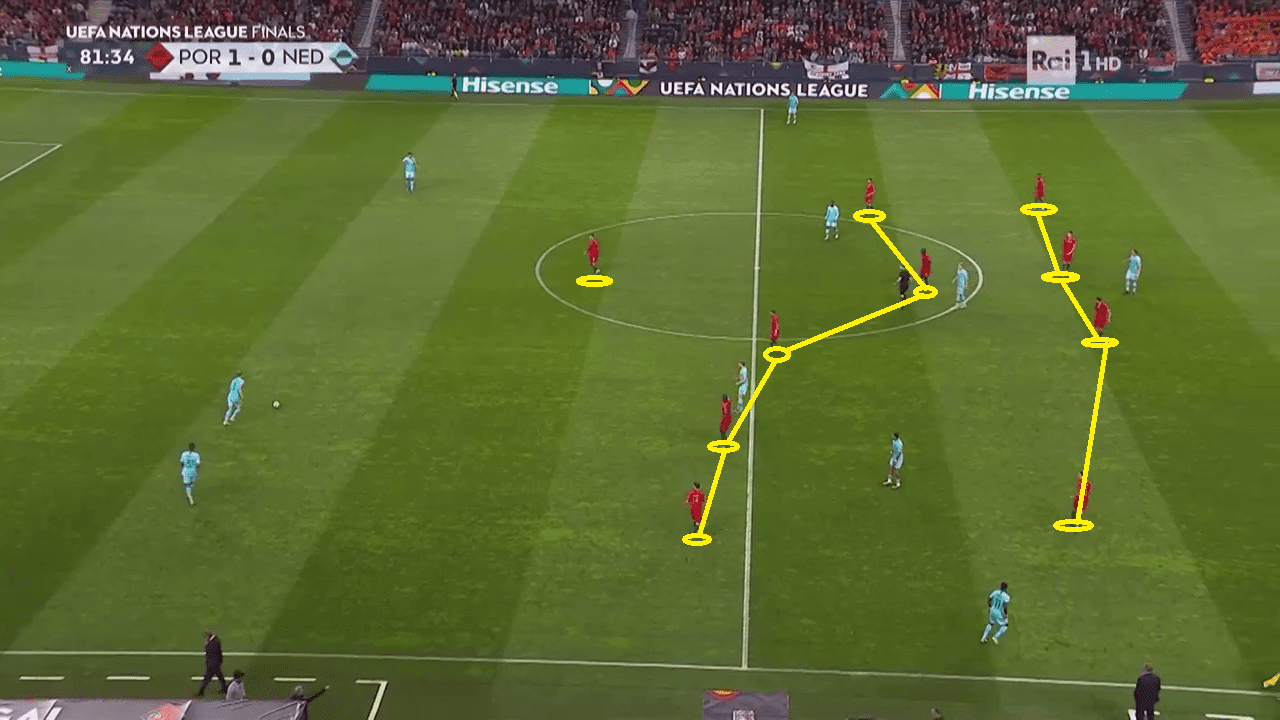
It led to a frustrating end for the Netherlands, whose best chance came as Luuk de Jong fired wide from a set piece chance. Just as throughout the game, the Dutch could not find a way to break down the organisation of the Portuguese side, despite the fact that they lacked the same technical quality. Santos’ rigid system held out and without the pace to disrupt it, particularly on the wings where Portugal left more space, the Netherlands simply couldn’t find a way to react.
Conclusion
As is often the case, this was Portugal showing up to a tournament and playing in their own style. There were no frills or skills, but it was all about pure efficiency. What was intriguing was that not only did Portugal shut the game down defensively, denying the Netherlands opportunities, but they also looked dangerous on the attack. Bernardo Silva’s magnificent display rightly earned him the player of the tournament award but also spread the burden, easing the weight on Cristiano Ronaldo and making Portugal more unpredictable in attack. Unfortunately for the Dutch, they had no such threat in their own attack and Koeman’s lack of flexibility saw him fail to find a way through a team which won the tactical battle to win the game.

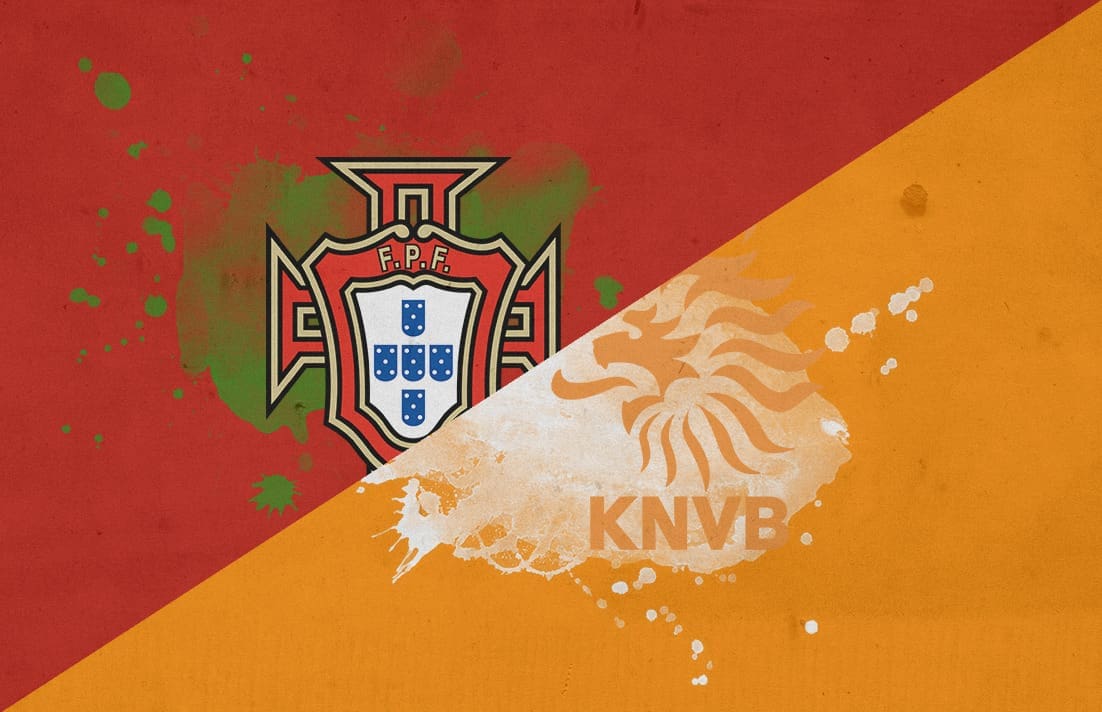



Comments